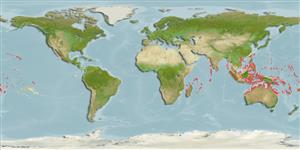Common names from other countries
Environment: milieu / climate zone / depth range / distribution range
البيئة
بحري مرتبطة بالشعاب; غير مهاجرة; نطاق العمق 0 - 20 m (Ref. 9710), usually 2 - 15 m (Ref. 37816). Tropical; 26°N - 25°S
Indo-Pacific: East Africa to Mangaréva, Tuamoto Islands and the Hawaiian Islands, north to Taiwan; throughout Micronesia.
الحجم / وزن / العمر
Maturity: Lm ? range ? - ? cm
Max length : 8.5 cm SL ذكر/ مختلط الجنس; (Ref. 9710)
الأشواك الظهرية (المجموع): 10; الأشعة الظهرية الناعمة (المجموع): 12; شوكة شرجية 3; أشعه شرجية لينه: 6. Irregular dark bars on body which may be broken into spots; 2 narrow diagonal bars on cheek; opercle and base of soft dorsal with large ocellated black spot (Ref. 5469).
A secretive species remaining in or near interstices of rock, coral, or rubble (Ref. 2334, 58302). Moderately common in seaward reefs in areas exposed to moderate surge or currents (Ref. 2334). Feeds on small crustaceans (Ref. 89972). Benthic (Ref. 58302). Minimum depth reported from Ref. 30874.
Life cycle and mating behavior
النضج | التكاثر | وضع البيض | بيض | الخصوبة | Larvae
Randall, J.E., G.R. Allen and R.C. Steene, 1990. Fishes of the Great Barrier Reef and Coral Sea. University of Hawaii Press, Honolulu, Hawaii. 506 p. (Ref. 2334)
IUCN Red List Status (Ref. 130435)
CITES (Ref. 128078)
Not Evaluated
استخدامات بشرية
حوض مائي: تجاري
مزيد من المعلومات
مراجعالأستزراع المائيملف الأستزراع المائيسلالاتجينيElectrophoresesالتوريثالأمراضمعالجةMass conversion
المتعاونينصورStamps, Coins Misc.اصواتالتسمم باكل السمكسرعةنوع السباحةمنطقة الخياشيمعظمة الأذندماغرؤية
أدوات
تقارير خاصة
Download XML
مصادر علي الأنترنت
Estimates based on models
Preferred temperature (Ref.
115969): 25.2 - 29.3, mean 28.4 (based on 2558 cells).
Phylogenetic diversity index (Ref.
82804): PD
50 = 0.5312 [Uniqueness, from 0.5 = low to 2.0 = high].
Bayesian length-weight: a=0.01585 (0.00637 - 0.03944), b=3.01 (2.79 - 3.23), in cm Total Length, based on LWR estimates for this (Sub)family-body shape (Ref.
93245).
مستوى غذائي (Ref.
69278): 3.5 ±0.6 se; based on size and trophs of closest relatives
Fishing Vulnerability (Ref.
59153): Low vulnerability (10 of 100).
